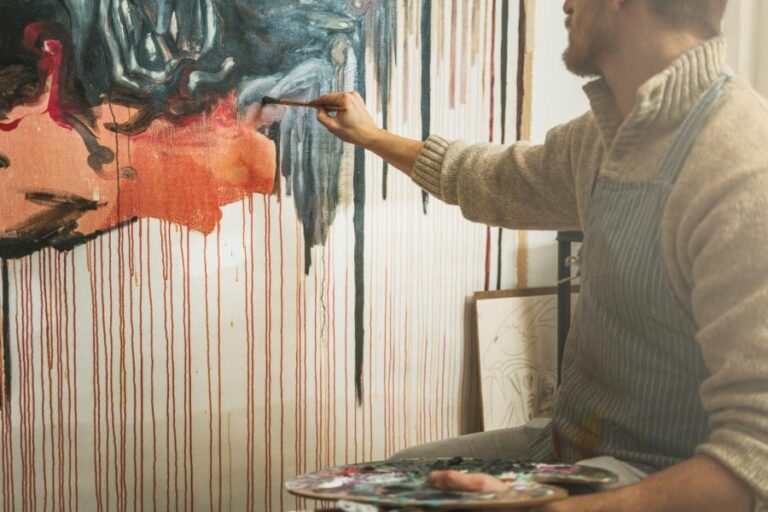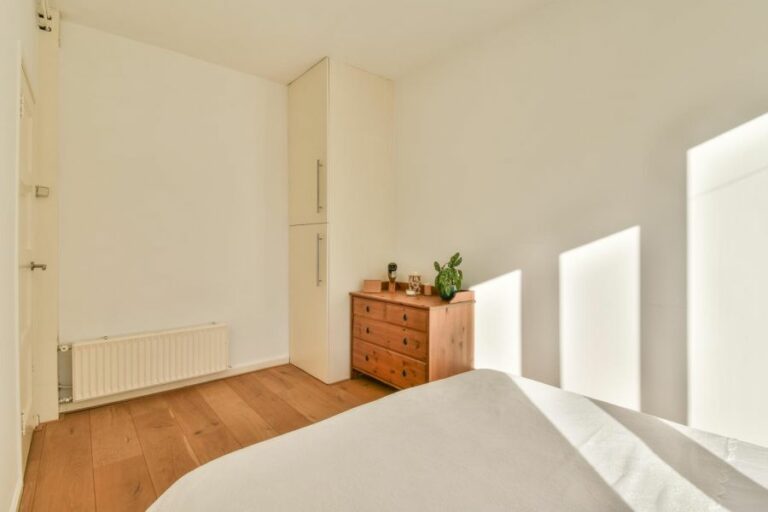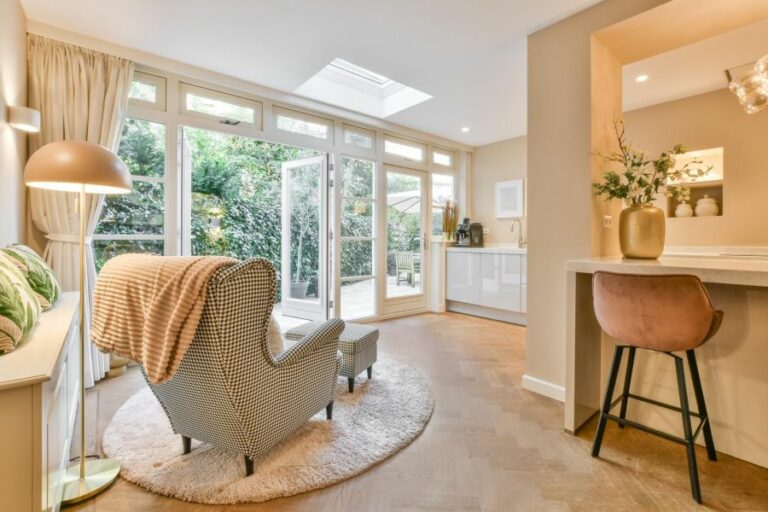Small Apartment Paint Color Ideas, 25 Things You Should Know
Are you living in a small apartment and feeling a bit cramped or overwhelmed by your current paint color? You’re in the right place! We have some fantastic paint color ideas that will not only make your small space look bigger but also turn it into a cozy and inviting haven. Trust us; it’s time to grab a paintbrush and transform your apartment into a stylish and comfortable home!
Small apartment paint color ideas:
To create the illusion of a larger space in a small apartment, use light and bright paint colors like whites, off-whites, pale grays, and soft pastels. Consider a monochromatic color scheme, add visual interest with accent walls, and create contrast with trims and ceilings. Some popular paint choices include Benjamin Moore’s Simply White, Farrow & Ball’s Pavilion Gray, and Sherwin-Williams’ Sky High.

Struggling to pick the perfect paint color for your small apartment? We’ve got you covered! Keep reading to find small apartment paint color ideas to create a spacious, stylish abode. Discover how the right hues can transform your living space.
Contents
- 1 Compact Apartment Color Scheme Inspirations
- 2 Top Wall Color Choices for Tiny Apartments
- 3 Colors that Amplify Space in Small Apartments
- 4 Picking the Perfect Paint Hue for Compact Living Spaces
- 5 Ideal Color Selections to Enhance Smaller Areas
Compact Apartment Color Scheme Inspirations
Choosing the right paint color for a small apartment can be challenging, but the right choice can make all the difference in creating the illusion of a larger space.
• Opt for Light and Bright Colors
In a small apartment, the key is to use light and bright colors, as these can make the space appear more open and inviting. Lighter colors will also help to increase the perception of space by reflecting light.
– Whites and Off-Whites
Whites and off-whites are classic choices, allowing for a clean and fresh look in a small apartment. They can also be easily paired with various furniture and accent colors. Check out Benjamin Moore’s Simply White for a perfect example of a crisp and clean white.
– Pale Grays
Pale grays can provide a sophisticated and modern look to any small apartment. They can be paired with a variety of colors and materials, making them a versatile option. Consider Farrow & Ball’s Pavilion Gray for a beautiful pale gray option.
– Soft Pastels
Soft pastel colors, such as pale pinks, greens, blues, and yellows, can create a soothing and calming atmosphere in a small apartment. These colors can also help to brighten the room and make it look more spacious. Benjamin Moore’s Love & Happiness is a lovely pastel pink to consider.
• Keep It Monochromatic
A monochromatic color scheme can make a small apartment feel more cohesive and less cluttered. By choosing one base color and varying the shades and tints, you can create depth and interest in the space without making it feel cramped.
– Blues
Blues are known for their calming and relaxing qualities, making them an ideal choice for a small apartment. Choose a light blue as the main color, and then use darker shades for accents and furniture. Sherwin-Williams’ Sky High is an excellent choice for a base blue.
– Greens
Greens can bring a sense of nature and tranquility into a small apartment. Stick to light shades of green as the main color, and use darker shades for accent walls or furniture. Check out Farrow & Ball’s Cromarty for a stunning light green option.
• Use Accent Walls
Accent walls can be an effective way to add a pop of color to a small apartment without overwhelming the space. By painting one wall or a portion of a wall in a bold color, you can create a focal point and add visual interest.
– Bold Yellows
A bold yellow accent wall can bring warmth and energy to a small apartment. Pair it with neutral or light colors on the other walls for balance. Sherwin-Williams’ Decisive Yellow is a great option for this purpose.
– Dark Purples
Dark purples can create a sense of luxury and depth when used as an accent wall in a small apartment. Combine it with lighter hues in the space for a balanced look. Benjamin Moore’s Shadow is a rich and striking option for a dark purple accent wall.
• Add Contrast with Trims and Ceilings
Painting trims, moldings, and ceilings in a contrasting colors can help create the illusion of a larger space. This will help draw the eye upward, making the ceilings appear higher and the room more spacious.
– White Trims and Ceilings
Painting trims and moldings in white or off-white can create a sharp contrast with the main wall colors, helping to visually expand the space. Using the same color for the ceiling will help open up the room even more.
– Dark Trims and Ceilings
For a bold and dramatic look, consider painting trims, moldings, and the ceiling in a dark color. This will create a strong contrast with the walls, making the room appear larger and more grand.
In conclusion, when choosing paint colors for a small apartment, focus on light and bright colors, consider a monochromatic color scheme, use accent walls to create visual interest, and add contrast with trims and ceilings.
By carefully selecting colors, you can transform your small apartment into a spacious and inviting home.
Color | Description | Effect on Small Spaces |
|---|---|---|
White | A classic, clean, and crisp color. | Expands and brightens the space. |
Light Gray | A soft and versatile neutral color. | Creates an open and airy feel, appears large. |
Soft Pink | A warm and inviting pastel shade of pink. | Adds a touch of warmth, makes the space feel larger and cozier. |
Light Blue | A cool and calming shade of blue. | Makes the room feel more spacious and serene. |
Pastel Yellow | A light and cheerful shade of yellow. | Brightens the space and gives it an uplifting feel. |
Light Green | A soothing and refreshing shade of green. | Creates a calming atmosphere and a larger appearance. |
Top Wall Color Choices for Tiny Apartments
• Choosing the Right Color
Selecting the appropriate wall color for a small apartment can be both challenging and exciting. The main goal is to create a visually-appealing and comfortable space. The apt color choice can significantly impact the overall aesthetic, mood, and feel of your home.
• Light Colors: Open and Airy
Small apartments require a color scheme that creates an illusion of openness and airiness. Lighter colors reflect more natural light, making the space appear larger and more inviting. Additionally, lighter colors tend to evoke pleasant emotions and lift the overall ambiance.
– Soft Neutral Colors
Soft neutral colors, such as whites, beiges, grays, and creams, are an excellent choice for several reasons:
- They reflect light effectively, making the room feel spacious.
- They act as a blank canvas, allowing you to play around with different colors in your decor and accessories. For example, you could add some vibrant-colored cushions, paintings, or rugs to create interesting contrast while still maintaining a sense of harmony and balance.
– Cool Tones
Cool tones, such as light blues, greens, and purples, are also great options for small apartment walls. These colors generate a calming effect, making your apartment feel like an oasis of relaxation. They are also psychologically associated with spaciousness. A study by Pantone found that cooler colors have a more substantial effect on perceived spaciousness than warmer colors.
– Pastels
Pastel shades of various colors, like pink, yellow, or lavender, can work wonders for small apartments. These colors add an instant charm and are excellent at creating a visually-pleasing backdrop that highlights your decor, furniture, and other belongings.
• Accent Walls: Adding Interest and Depth
Incorporating an accent wall within a small apartment can add depth and dynamic to the space. This technique involves painting one wall a bold or darker color while keeping the rest of the apartment’s walls in light neutral shades. The contrast adds visual interest and elegantly breaks up the monotony.
Some popular accent wall colors include:
- Deep blues or teals
- Forest greens
- Charcoal grays
- Warm browns
• Additional Tips for Maximizing Space
In addition to selecting the ideal wall color, there are various tips to make your small apartment look larger and more spacious:
– Use Mirrors
Mirrors are a fantastic way to create an illusion of depth and space. Place mirrors strategically across from windows or sources of light, reflecting light around the room and giving an airy feel.
– Choose Multi-Functional Furniture
Opt for pieces of furniture that provide storage options or can serve multiple purposes. For example, get a bed frame with built-in storage or a sofa that doubles as a pullout bed.
– Keep Clutter at Bay
Reducing clutter and staying organized can make the apartment feel larger. Use creative storage solutions and keep surfaces clean and clear.
– Opt for Light-Colored Furniture
Choosing furniture in light neutral colors, such as whites, grays, or beiges, can help make the space appear more open and less crowded.
• In Summary
The best color for small apartment walls is one that creates an open, light, and inviting atmosphere. Soft neutral colors, cool tones, and pastel shades are highly recommended. Additionally, consider incorporating an accent wall, utilizing mirrors, and opting for light-colored furniture to make your living space appear larger and more expansive.
With the right color choice and some smart design decisions, your small apartment can become a comfortable, visually-pleasing home.
Color | Reason |
|---|---|
White | White creates a clean and minimalistic look, as well as making spaces look larger and more open. |
Light Gray | Light Gray adds a touch of sophistication while also reflecting light to make the space look larger. |
Soft Blue | Soft Blue creates a calming atmosphere while also giving the illusion of a more spacious room. |
Light Green | Light Green adds a refreshing and natural touch to a small space, without feeling too overwhelming. |
Beige | Beige provides a warm and cozy atmosphere while still maintaining the illusion of a bigger space. |
Colors that Amplify Space in Small Apartments
As someone with experience in interior design, I understand the importance of picking the right colors for your small apartment. Color can greatly impact the perceived size of your living space, making it feel larger or more confined.
• The Power of Light Colors
Light colors are generally considered the best choice for making a small apartment look bigger. Light colors reflect light and make a room feel brighter and more open. Here are the key light hues I recommend utilizing in a small living space:
– Whites and Off-Whites
White is the classic color choice for opening up a small area. It reflects light well, creating a spacious and airy feeling. Off-white hues such as soft cream, eggshell, and ivory can achieve a similar effect while adding a touch of warmth to your space.
– Soft Grays
Soft grays, particularly those with cool undertones, are a popular modern choice for small apartments. They provide a neutral backdrop that works well with various decorating styles and makes your living space feel more open.
– Light Pastels
Pastel shades like pale pink, mint green, and powder blue add a touch of color to your apartment without making it feel smaller. These colors also work well in creating a cozy atmosphere, perfect for a small apartment.
• Color Combinations that Enhance Space Perception
Pairing the right colors can further amplify the effect of making your space feel larger. Here are some expert-approved combinations to try in your small apartment:
– Monochromatic Color Schemes
Using different shades of the same color creates a cohesive and visually harmonious look. This approach can make a small apartment seem more spacious because it eliminates the need for contrasting colors, which can break up space and make it feel more confined.
– Analogous Colors
Analogous colors are those situated next to each other on the color wheel. Pairing these together creates a subtle yet visually appealing look, which can help enhance the perception of space in your apartment.
• Strategic Use of Accent Colors
While lighter shades are recommended for opening up small spaces, it is still important to incorporate some darker or bolder colors. Including accent colors can add depth and create visual interest in your small apartment. Here are some tips for using accent colors effectively:
– Limit the Number of Accent Colors
Too many different colors can create visual clutter, making your space feel cramped. Stick to one or two accent colors to maintain a balanced and open look.
– Use Accents to Direct Attention
Place accent colors strategically to draw attention to specific areas or features in the room. This can help create a sense of depth, making the space feel larger.
– Incorporate Accents through Accessories
Utilize bold colors in accessories, such as pillows, artwork, or smaller decorative items. This approach allows you to add color without overwhelming the space.
• Additional Tips for Creating a Spacious Look
Beyond color choices, other design elements can also contribute to making your small apartment look bigger. Some useful tips include:
– Use Mirrors
Mirrors reflect light and can create the illusion of a larger space. Strategically placed mirrors can help enhance the effects of your color choices in making the room feel bigger.
– Opt for Minimalist Furniture
Choose furniture that is sleek and minimalist, as bulky pieces can make a small space feel crowded. Additionally, furniture with exposed legs can create a feeling of more openness.
– Embrace Vertical Space
Utilize vertical space by adding tall bookshelves or hanging shelves on the walls. This draws the eye upward and helps create the illusion of height in your apartment.
For more information on color and space perception, visit the Color Matters website, which offers valuable insights into color theory and design principles.
In conclusion, making a small apartment look larger is achievable with the right color choices and strategic design decisions. Opt for lighter shades, employ complementary color schemes, use accents wisely, and incorporate additional design elements like mirrors and minimalist furniture.
With these expert recommendations, you can create a more spacious and inviting living area in your small apartment.
Picking the Perfect Paint Hue for Compact Living Spaces
Selecting the right paint color for a small apartment can be a daunting task, but it doesn’t have to be. With the proper guidance, you can create a warm, inviting space that feels expansive and bright.
• Understanding Color Psychology
Color psychology plays a crucial role in how different hues affect our mood and emotions. In small apartments, this becomes even more important as you want to create a space that feels comfortable and inviting. Here’s a brief overview of the psychological effects of some common colors:
- White: Cleanliness, simplicity, and space
- Gray: Elegant, sophisticated, and calming
- Blue: Serenity, relaxation, and tranquility
- Green: Growth, renewal, and balance
- Yellow: Happiness, energy, and warmth
- Red: Passion, excitement, and intensity
- Brown: Stability, reliability, and warmth
Keep these psychological effects in mind when selecting paint colors for your small apartment. Consider how you want to feel in each room and choose colors accordingly.
• Light Vs. Dark Colors
There’s always an ongoing debate about whether to use light or dark colors in a small space. The truth is both can achieve fantastic results if used correctly. Here are some pointers for utilizing both light and dark colors in a small apartment:
– Light Colors
Light colors, such as white, cream, and soft pastels, can create the illusion of a more spacious and open area. They reflect light, which can make the space appear brighter and airier. Consider using a light color on your walls and ceiling to increase the perceived height of the room.
Light colors are especially effective in living rooms, kitchens, and bedrooms to create a calming atmosphere.
– Dark Colors
Contrary to popular belief, dark colors can also work well in small spaces. Bold, dark hues, such as navy, charcoal, or deep green, can add depth and character to the room. However, it’s essential to balance them with lighter accents in furniture or decor to prevent the area from feeling claustrophobic.
Dark colors are particularly suitable for spaces like home offices, where you want to create a sense of focus and concentration.
• The Role of Accent Colors
Choosing the right accent colors is crucial to tying your entire color scheme together. Accent colors can be used in a variety of ways, from furniture and decor to an accent wall. Here’s how you can effectively use accent colors in your small apartment:
- Choose an accent color that complements the colors already in your space. You can use a color wheel to help identify complementary colors (for example, similar shades or contrasts).
- Avoid using too many different accent colors, as this can make the room feel cluttered and chaotic. Stick to one or two primary accent colors that coordinate well with each other.
- Use your accent colors strategically throughout the space by incorporating them into artwork, pillows, curtains, or other decorative items.
• Consistent Color Scheme Throughout the Apartment
In a small apartment, maintaining a consistent color scheme throughout the space can help create a seamless flow and a cohesive feel. This doesn’t mean every room needs to have the same wall color, but try to stick to similar hues or tones.
For example, if your living room features calming, cool colors like blues and greens, consider carrying those shades throughout the rest of the apartment.
• Test Paint Colors Before Committing
Before committing to a paint color, it’s a good idea to test it in your space. Purchase a small sample of your chosen color and paint a small patch on your wall. Observe how the color looks at different times of the day and under various lighting conditions.
• Consult a Color Expert
Lastly, don’t be afraid to consult a color expert or interior designer for guidance. Many paint stores offer color consultations, and online resources like Benjamin Moore’s Personal Color Viewer can help you visualize different color combinations in your space.
Remember, there’s no one-size-fits-all approach to choosing paint colors for a small apartment. Take the time to explore different colors and combinations to find the perfect paint color that best reflects your personal style and creates the atmosphere you desire. Happy painting!
Step | Description |
|---|---|
1 | Consider the room’s purpose and the mood you want to create. |
2 | Take note of the natural lighting in the space. |
3 | Choose lighter colors to create an illusion of more space. |
4 | Use complementary colors for accents and smaller areas. |
5 | Factor in the color of your furniture and decorations. |
6 | Test sample colors on the walls before making a final decision. |
7 | Consider using different finishes for added visual interest and depth. |
8 | Remember that paint colors can be easily changed if you’re not satisfied with the outcome. |
Ideal Color Selections to Enhance Smaller Areas
Creating a comfortable and visually appealing atmosphere in a small space can be challenging. Choosing the right color scheme is a crucial step in making a small room feel more spacious and inviting.
• Light and Neutral Colors
Light and neutral colors generally make a room feel more spacious and open. These colors are ideal for small spaces because they reflect light better than dark colors, creating an illusion of a larger area.
– White
White is the ultimate color for creating a sense of space, as it reflects light better than any other color. A pure white room can feel clinical and sterile, so it’s essential to introduce texture and warmth through fabrics, furniture, and accessories.
A soft off-white or a warmer shade, such as cream or ivory, can help create a more inviting atmosphere.
– Gray
Light gray shades are a popular choice for a minimalist and contemporary look. A cool, light gray can create a calming atmosphere and is versatile enough to work with a variety of accent colors.
Warmer gray tones, like taupe or greige, can add a touch of warmth to a space and blend well with other neutrals and soft colors.
– Beige and Tan
Warm and inviting, beige and tan shades can create a cozy feeling in a small space. These colors can be paired with darker accents to add depth and visual interest. Light tans and soft beiges work best in small spaces, as darker shades can make a room feel smaller.
• Cool Colors
Cool colors, such as blues, greens, and purples, can create a calming and serene atmosphere in a small space. These colors often have a receding effect, making the walls appear further away and therefore making the room appear larger.
– Light Blue
Light blue tones can evoke feelings of tranquility and relaxation, making them a popular choice for bedrooms and bathrooms. Here is an article on Choosing Paint Colors from the University of Idaho that can help you make better color choices.
Keep the shades soft and muted, such as a pale sky blue or a cool aqua, to prevent the room from feeling too cold.
– Pale Green
Pale green shades, like sage or mint, can help create a soothing and nature-inspired atmosphere in a small space. Use these colors to bring a touch of the outdoors inside, creating a refreshing and calming environment.
– Lavender
A soft lavender shade can add a touch of femininity and elegance to a small room. This cool, light purple hue can create a calming atmosphere, perfect for a bedroom or a cozy reading nook.
• Using Accent Colors
While light and cool colors are ideal for small spaces, adding touches of darker accent colors can provide depth, interest, and personality to the room. Here are some tips for using accent colors in a small space:
- Focus on small areas: Introduce bold or dark accent colors in small areas, such as a single feature wall, a statement piece of furniture, or decorative accessories.
- Choose harmonious colors: When picking an accent color, opt for shades that work well with your primary color choice. This will help create a cohesive and harmonious look.
- Avoid clutter: Keep the room decluttered and organized to prevent it from feeling cramped or claustrophobic.
• Conclusion
In conclusion, the best colors for a small space are light and neutral shades, as well as soft cool colors, which reflect light and create a feeling of spaciousness. Don’t be afraid to experiment with accent colors to add depth and personal flair to your small space.
Remember, a well-organized and clutter-free space will also contribute to making your small room feel larger and more inviting.
No. | Color | Reason |
|---|---|---|
1 | White | Reflects light and creates a sense of openness. |
2 | Light Gray | Neutral color that adds depth without overpowering the space. |
3 | Soft Blue | Creates a calming atmosphere and gives an illusion of a bigger space. |
4 | Light Green | Invokes a feeling of nature and makes the space appear larger. |
5 | Pale Yellow | Brings warmth and a welcoming vibe to a small space. |







